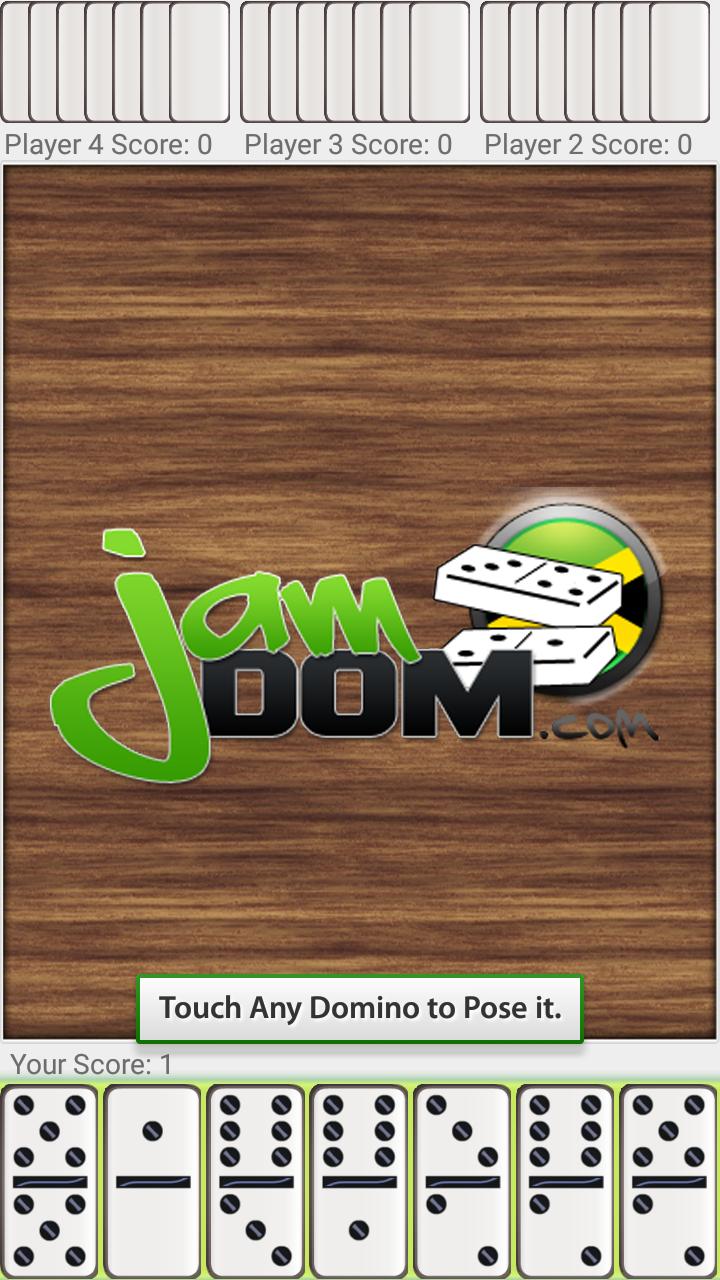

Learn to Play Jamaican/Caribbean Style Dominoes or Prove You're Already the Don!
At JamDom.com, we play Jamaican Style Dominoes, in the REALEST, most authentic way. Wenn Sie nach einer Herausforderung gegen echte Live -Spieler in 6 verschiedenen Spielstilen und Turnieren suchen, melden Sie sich von Ihrem Laptop oder Desktop bei Jamdom.com an, um zu sehen, wie Sie zu den besten Spielern in der Karibik und dem Rest der Welt rangieren!
Wenn Sie lernen möchten, wie Sie spielen oder einfach nur bequem Dominosteine von Ihrem mobilen Gerät ausgehen möchten, während Sie ohne Internetverbindung GO ohne die App für eine Internetverbindung herausholen möchten, probieren Sie diese Übungs -App aus.
If you are new to the Jamaican/Caribbean style of playing, then here is run down of the rules to get you up and running...
This App Features the Cut Throat Game Style, where the Player who Drops SIX LOVE is the winner!
There are a total of 28 Dominoes, and they are labelled in 7 different suites or series as follows:
6-6, 6-5, 6-4, 6-3, 6-2, 6-1, 6-0
5-5, 5-4, 5-3, 5-2, 5-1, 5-0
4-4, 4-3, 4-2, 4-1, 4-0
3-3, 3-2, 3-1, 3-0
2-2, 2-1, 2-0
1-1, 1-0
0-0
At the start of each Round, the 28 dominoes are shuffled and distributed randomly to the 4 Players at the table. Each player draws 7 dominoes from the shuffled pool of dominoes.
In the First Game of the Set, the player who draws the Double 6 domino is the Player who will POSE. The Poser is the Player to play the First Domino at the start of the game.
After the Pose, the Turn moves to the player to the right (counter clockwise) of the Poser. The next play is made by playing any card of the 6-suite, for example 6-5 or 6-2, to connect with the Double 6 that was already posed.
If the Next Player does not have a domino with a "6" in their hand, this player will PASS, which simply means the turn skips to the next player.
Let's say that Player #2 decides to play 6-5 on the 6-6 (Double 6) pose. Jetzt hat Spieler Nr. 3 die Wahl, entweder eine 6 oder eine 5 zu spielen. Wenn sie keinen Domino haben, der zum 6-Suite oder 5-Suite gehört, passieren sie, und die Kurve geht zum nächsten Spieler.
This same pattern of matching or connecting dominoes continues until a player is able to play all their tiles first.
The first player to play all their dominoes is the winner of that game. The winner receives 1 point added to their score or 2 points for winning with a KEY CARD!
Eine Schlüsselkarte ist ein zweigesichtiger Domino, zum Beispiel 4-3, der sich mit beiden Enden des Boards verbindet, als die letzte Karte, die von einem Spieler als Gewinnkarte gespielt wird. In order for it to be a Key Card, it must also be the 7th (last) member of the suite for both suites that it belongs to. Wenn also 4: 3 der gewinnende Domino des Spielers war und eine 4 auf einem der Brett und ein 3 in der anderen und 6 Teile von 4 und 6 Teilen 3 gespielt wurden, gilt der 4: 3 als Schlüsselkarte.
The winner of a game becomes the Poser of the next game.
In some cases, the game may also be BLOCKED, meaning that every player passes and no player has yet played all their cards. This happens when all 7-members of a suite have already been played and these are the only exposed values to play on at either end of the board.
The winner of a blocked game is the person who has the LOWEST COUNT of all the pips/dots on ALL of their dominoes, collectively. Meaning, if you have 3-2 and 5-5 remaining in your hand when the game is blocked, the total count of your hand is: 3 + 2 + 5 + 5 = 15.
If there is a TIE for the lowest count, then the game is a DRAW and the next game is played for 2 points. Since there was no clear winner, in the next round, the player who draws Double 6 (6-6) will pose.
Im 6-Liebenden-Cut-Halsstil ist der Spielersatz vorbei, wenn ein Spieler eine Gesamtpunktzahl von 6 erreicht, während mindestens ein anderer Spieler bei einer Punktzahl von 0 bleibt (6: 0).
Alternatively, the game is said to be "BRUCK" or broken if every player scores at least 1 point before any player is able to reach 6 points.
Erweitern
Veröffentlichungsdatum
Größe
Kategorie
KartenstrategiePaketname